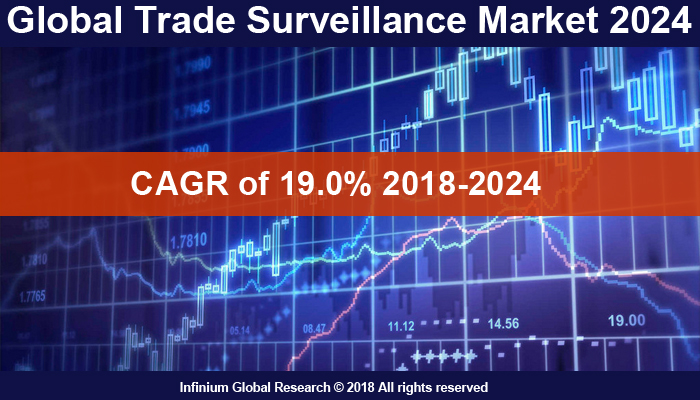Trade Surveillance Market (Deployment Type - On-premises and Cloud; Component - Solutions and Services): Global Industry Analysis, Trends, Market Size and Forecasts to 2024
A recent report published by Infinium Global Research on trade
surveillance market provides an in-depth analysis of segments and sub-segments in
global as well as regional trade surveillance market. The study also highlights
the impact of drivers, restraints and macro indicators on the global and
regional trade surveillance market over the short term as well as long term.
The report is a comprehensive presentation of trends, forecast and dollar
values of global trade surveillance market. According to the report the global
trade surveillance market is projected to grow at a CAGR of 19.0% over the
forecast period of 2018-2024.

Market Insight
Trade surveillance is the surveillance system that monitors and detects suspicious activities from market
manipulation, fraud, and illegal trading practices in the securities market. It
helps to ensure orderly markets where the buyers and sellers are willing to
participate owing to the confidence in the fairness and accuracy of
transactions. The main intention of trade surveillance is to focus on effective
internal control, effective workflow management, and extensive business rules
engines.
The requirement for monitoring
trade activities in financial institutions is expanding rapidly this is
anticipated to be the key factor driving the growth of the trade surveillance
market. Additionally, regularity and internal agreement are the factors
propelling the growth of the market. However, non-standardization of the compliance
and design and implementation of the surveillance system are hampering the
growth of the market during the forecast period. Furthermore, the need for modern
and proactive trade surveillance is the factor providing several growth
opportunities for the key players in the trade surveillance market. On the
other hand, to automate, enhance and manage the surveillance system for
improves efficiency the enterprises are executing trade surveillance system
solutions.
Among the geography, North
America is anticipated to hold the largest market for the trade surveillance market
followed by the Asia-Pacific. Moreover, rising trading services in the European
market regarding fraud and manipulation is high which helps the needs to
implement trade surveillance that also enables firms to adapt to change
regulatory requirements. On the other hand, Middle East countries such as Saudi
Arabia and Qatar holds the largest revenue share for the trade surveillance
market and these countries are now adopting IP-based surveillance systems for
upgrading the trading scheme.
Segment Covered
The report on global trade surveillance market covers segments
such as deployment type and component. On the basis of deployment type, the global trade surveillance market is
categorized into on-premises and cloud. On the basis of component the
global trade surveillance market is categorized into solutions and services.
Geographic Coverage
The countries covered in the North America region include the
U.S., Canada, and Mexico; while Asia-Pacific includes China, Japan, India,
South Korea, Malaysia, and among others. Moreover, Germany, U.K., France,
Spain and Rest of Europe are included in the European region. The U.S. drives
the growth in the North America region as it is the largest market in the
region. The Asia-pacific region offers a substantial potential for the market
growth owing to rapid growth in markets such as India and China. The APAC
region is projected to experience growth at a CAGR of x.x% over the period of
2018-2024.
Companies Profiled:
The report provides profiles of the companies in the global
trade surveillance market such as ACA Compliance Group,
B-Next, IPC, SIA S.P.A., Aquis Technologies, Cinnober,
Nasdaq, Software AG and FIS.
Report Highlights:
The report provides deep insights on demand forecasts, market
trends, and micro and macro indicators. In addition, this report provides
insights into the factors that are driving and restraining the global trade
surveillance market. Moreover, IGR-Growth Matrix analysis given in the report
brings an insight into the investment areas that existing or new market players
can consider. The report provides insights into the market using analytical
tools such as Porter's five forces analysis and DRO analysis of trade
surveillance market. Moreover, the study highlights current market trends and
provides forecast from 2018-2024. We also have highlighted future trends in the
trade surveillance market that will impact the demand during the forecast
period. Moreover, the competitive analysis given in each regional market brings
an insight into the market share of the leading players. This report will help
manufacturers, suppliers, and distributors of the trade surveillance market to
understand the present and future trends in this market and formulate their
strategies accordingly.
